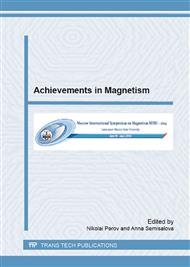p.607
p.611
p.615
p.619
p.623
p.629
p.633
p.639
p.643
Effect of Secondary Decomposition on Coercivity of Fe-Co-Cr Alloys with 15% Co
Abstract:
The microstructure and magnetic properties of Fe-Co-Cr alloys with 15 wt % Co were investigated using transmission electron microscopy and magnetic measurements. The secondary decomposition within both the α2-phase matrix and the α1-phase particles was observed for magnets subjected thermo-magnetic treatment and subsequent stepped aging or continuous-cooling treatments. During high-temperature treatments (630-600 оC), when the α2 phase is dominant (the volume fraction is more than 50%), the secondary decomposition of this phase takes place (α2 → α1' + α2'). The deterioration of magnetic insulation of α1-phase particles results in the decrease in the coercive force of alloys. Below 600 оC, when the α1 phase is dominant (the volume fraction is more than 50%), the splitting of elongated α1-phase particles occurs. When the temperature of stepped-aging decreases in high steps, the secondary decomposition (α1 → α1' + α2') leads to the splitting of initial α1-phase particles into fine slightly elongated particles and the decrease in the coercive force.
Info:
Periodical:
Pages:
623-628
Citation:
Online since:
July 2015
Authors:
Price:
Сopyright:
© 2015 Trans Tech Publications Ltd. All Rights Reserved
Share:
Citation:


